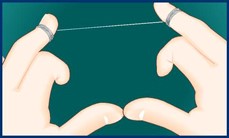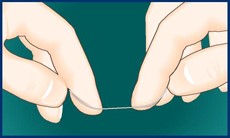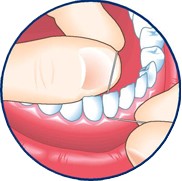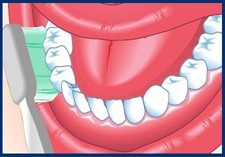Key Takeaways
- Brushing and flossing remove food debris from your mouth and prevent the buildup of plaque. Plaque build-up contributes to tooth decay and gum disease.
- Whether using an electric or a manual toothbrush, you want to ensure you have the proper brushing technique.
- Cleaning between your teeth removes plaque from areas your toothbrush can’t reach.
On this page
Brushing
Brushing your teeth at least twice a day helps prevent tooth decay and gum disease. Be sure to do it properly. Here’s how:
- Use a small amount of fluoride toothpaste. Fluoride helps to strengthen the tooth’s enamel. You only need a small amount (about the size of a pea). For children younger than three (3) years of age, apply a rice grain smear of fluoridated toothpaste if the child is at risk of decay.
- Hold your toothbrush at a 45-degree angle. Brush with short, gentle strokes on all outside and inside surfaces for three minutes.
- Avoid hard scrubbing. Brushing too hard can damage your enamel. Be sure to avoid scrubbing side to side as this can damage your enamel and gums.
- Brush your tongue to remove residue from food and beverages. It also freshens your breath!
- Brush your teeth every morning and night before you go to sleep.
Avoid brushing your teeth for an hour after eating acidic foods or drinks. The acid can remain on the enamel and you end up brushing away the enamel.
Toothbrushes
There is a huge selection of toothbrushes available, both manual and electric. It’s a good idea to choose one that:
- has a small head so it’s easier to move around inside your mouth
- has soft bristles
- fits comfortably in your hand
It’s also important to take care of your toothbrush. Rule number one: Do not share your toothbrush or use someone else’s toothbrush!
Using your own toothbrush prevents the spread of bacteria and viruses. Bristles can cause minor scraping to your gums. This could allow bacteria to enter your bloodstream.
Other tips to keep in mind:
- After brushing, rinse your toothbrush with water and allow it to air-dry. Do not store in a closed container
- Store your toothbrush standing upright. If it’s near other toothbrushes, do not let the heads touch.
- Replace your toothbrush every three to four months or when the bristles look worn and bent, whichever comes first.
- You should also use a new toothbrush after a cold or illness. Germs can stay on toothbrush bristles and lead to reinfection. You may wish to consider using an electric brush instead of a manual brush. Electric brushes have been shown to better maintain your oral health.
Toothpaste
The best toothpaste to use can depend on the state of your dental health. There are special kinds of toothpaste for sensitivity and gum disease. Your dentist will be able to recommend the best one for you. Make sure your toothpaste contains fluoride.
For children under the age of three, talk to your dentist. They can tell you if toothpaste is recommended. For kids three to six years of age, use only a small amount of toothpaste – the size of a green pea. Make sure your child does not swallow the toothpaste.
Oral Rinses
Oral rinses are liquids to swirl in your mouth for a variety of dental issues. Make sure you don’t swallow!
They range from simple mouthwashes that fight bad breath to ones that contain fluoride. There are also special types that fight plaque and gum disease. Oral rinses are not a substitute for brushing and flossing your teeth. They’re also not generally recommended for children under six years of age.
Your dentist can suggest what oral rinses would be best for you.
Flossing
The act of gently massaging a plastic string between each tooth isn’t appealing to a lot of people. But it serves a very important purpose.
Flossing not only removes food debris from places your toothbrush can’t reach. It also disrupts cavity-causing bacteria from breeding between your teeth. It’s important to do it every day.
Traditional floss can be difficult to use for some people. There are other options available:
- dental tape, which is a flatter and wider version of floss
- dental picks
- pre-threaded flossers;
- interdental brushes that reach between the teeth
- water flossers
- wooden or plastic sticks.
You can always ask your dentist what types of product is best for you and how to use it.

Step 1: Take a length of floss equal to the distance from your hand to your shoulder.

Wrap it around your index and middle fingers, leaving about two inches between your hands.

Step 2: Slide the floss between your teeth and wrap it into a “C” shape around the base of the tooth and gently under the gumline. Wipe the tooth from base to tip two or three times.
Step 3: Be sure to floss both sides of every tooth. Don’t forget the backs of your last molars. Go to a new section of the floss as it wears and picks up particles.

Step 4: Brush your teeth after you floss – it is a more effective method of preventing tooth decay and gum disease. When flossing between two teeth, remember to arc the floss gently below the gum to clean each tooth properly.
How to choose your dental products
A trip to the store to purchase dental products can be daunting – which ones to choose? Ask your dentist to recommend what works for you. You can also look for the CDA Seal.
